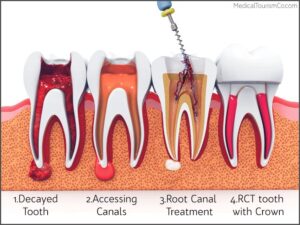Root Canal Treatment

A root canal refers to a dental procedure which treats infection that is in the middle of a tooth. The procedure is also known as “endodontic”. Tooth infection is usually caused by bacteria that lives in the mouth and invades the tooth normally after tooth decay, leaky fillings or damage to the teeth due to trauma like a fall.
The pulp consists of soft tissues that include blood vessels and nerves. When infected by bacteria, the pulp begins to die as the bacteria starts to multiply and spread. When this process continues, the tissues around the tooth become red and swollen making your tooth painful or worse, your face becoming swollen. This procedure involves removing the pulp and thereafter cleaning and sealing the tooth canal.
WHEN TO CONSIDER ROOT CANAL TREATMENT
The root canal treatment procedure is only necessary when it is clear that the pulp has been infected and damaged by bacteria. Your dentist will be able to establish the infection using dental X-rays to take the images of your teeth, which will be used to identify any problems. The symptoms to look out for are severe toothache during chewing or when applying pressure, prolonged sensitivity to either hot or cold temperatures, tooth discoloration, swelling and tenderness of the gums and a pimple that recurs on the gums.
THE PROCEDURE OF THE ROOT CANAL
Before undergoing a root canal treatment, you will require one or more visits to the dentist or endodontist. Thereafter, a series of steps will be followed:
X-RAY
The very first step in this treatment is to have an x-ray to be able to see the root canals and confirm if the surrounding bone is infected.
ANESTHESIA
The dentist will then numb the area around the tooth using a local anesthesia. This is to make the patient feel more at ease and relaxed. After that a rubber dam is placed around the tooth so that the area can remain dry and saliva free during treatment.
PULPECTOMY
The next step is to drill an access hole into the tooth. The pulp together with the bacteria and the nerve tissue that is decayed together with other related debris are removed from the tooth. The cleaning process is then done by the use of various root canal files. A series of the files with increasing diameter are subsequently placed in the access hole then worked down the whole length in order to scrape and scrub each side of a root canal. The debris are then flushed away using water or sodium hypochlorite.
SEALING
Once thoroughly cleaned, the tooth is sealed. Some dentists choose to give it a week before sealing while others prefer to do it the same day that it is cleaned. The sealing is done using a rubber compound by the name gutta percha which is usually placed in the root canal of the tooth. The very last step involves further restoration of the tooth. A crown or other restoration has to be put on the tooth in order to protect it and prevent it from breaking so that it can restore its full function.
THE ROOT CANAL AFTER CARE
During the first days after the completion of the procedure, tooth sensitivity may be experienced because of the natural tissue inflammation. This discomfort can be controlled using over-the-counter painkillers such as ibuprofen or naproxen. It is advisable that you minimize on chewing until the procedure is finished completely. This will help you avoid re-contamination and also to prevent the breakage of a fragile tooth before it is fully restored. Some of the reasons for pulp and tooth inflammation are deep decay and several dental procedures on the same tooth. Good oral hygiene practices that include brushing your teeth twice a day coupled with regular dental visits will reduce the need for root canal procedures.
LEARN MORE ABOUT ROOT CANAL
You have to be treated with the best hands for this procedure to be painless and comfortable. To learn more, please call us at 305-442-0331
